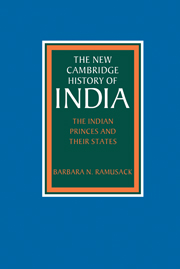Although there is a voluminous historiography on the princely states, it is uneven in its coverage, readability and scholarship. Consequently the secondary sources cited are those that I have found most useful or distinctive in their interpretations. Where authors have first published on their topics in journals and then substantially incorporated their articles into a monograph, I have cited only the titles of books, which are usually more developed statements of their research. Moreover, in my footnotes I have cited dissertations and unpublished papers but not included them here since they are more difficult to obtain. Since primary sources are the building blocks for the edifices of historians, I have included a few major collections of key documents, influential histories by British officials, and memoirs of British officials and Indian princes. Finally, all works are cited only once even where they are relevant to the topics of more than one chapter.
Princely States prior to 1800
Thought-provoking analyses of the underpinnings of kingship in India are J. Gonda’s Ancient Indian Kingship from the Religious Point of View (Leiden, 1969); J. C. Heesterman’s The Inner Conflict of Tradition: Essays in Indian Ritual, Kingship, and Society (Chicago, 1985); and Ronald Inden’s ‘Ritual, Authority, and Cyclic Time in Hindu Kingship’, in J. F. Richards (ed.), Kingship and Authority in South Asia (Madison WI, 1978), pp. 28–73. Bernard Cohn developed an influential structural model that elegantly categorises differing levels of state formation in ‘Political Systems in Eighteenth Century India: The Banaras Region’, JAOS 82 (1962), pp. 313–20.
